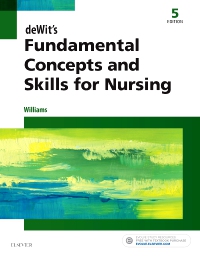
deWit's Fundamental Concepts and Skills for Nursing - Elsevier eBook on Vitalsource, 5th Edition
Elsevier eBook on VitalSource

Now $80.74
Fundamental Concepts and Skills for Nursing, 5th Edition provides all the basic theoretical and applied knowledge that the LPN/LVN nurse needs to practice in an expanded number of care settings, such as the community clinic, physician’s office, long-term care facility, home, and acute-care hospital setting. With an extensive art program and thorough discussion of QSEN, this text addresses topics like the physical and psychosocial needs of the patient, critical thinking for problem solving and clinical judgment, and communication — all within a strong nursing process framework. The accessible, friendly, and clear writing style appeals to students and instructors, and its rich ancillary package, including NCLEX-PN® review questions, gives students an edge on learning fundamentals.
Newer Edition Available
-
- Concept maps give a visual example of concepts addressed in the text, help you visualize difficult material, and illustrate how a disorder’s multiple symptoms, treatments, and side effects are associated.
- Over 110 skills and steps, featuring sample documentation examples and Home Care Considerations boxes where appropriate, present step-by-step procedures in an action/rationale format.
- Life Span Considerations: The Older Adult highlight changes that occur with aging and how they affect nursing care by LPN/LVNs working in community and long-term care.
- Easy-to-follow reading level and text organization presents information from simple to most complex, making it perfect for lower level students and those speaking English as a second language.
- Numbered objectives, divided by theory and clinical practice, provide a framework for content.
- Cultural Considerations cover biocultural variations, as well as health promotion for specific ethnic groups, so you provide culturally competent care.
- Health Promotion and Patient Teaching boxes include guidelines to prevent illness, promote health, and develop self-care strategies.
- Nursing process framework features application of the nursing process and nursing care plans to reinforce application of the nursing process in the clinical setting.
- Think Critically boxes encourage you to synthesize information and apply concepts to practice.
- Home Care Considerations boxes highlight the necessary adaptations of nursing skills and techniques for the patient in the home care setting.
- Communication boxes present examples of nurse-patient dialogues and instructive therapeutic communication techniques.
- Over 20 nursing care plans, which include critical thinking questions at the end of the text, provide you with a model for planning patient care.
- Clinical chapters provide an overview of structure and function to give you a refresher in related anatomy and physiology, including a section on aging.
- Key terms include phonetic pronunciations, which are helpful for ESL students, and text page references to find the definition.
- Standard LPN Threads features include helpful characteristics such as full-color design, key terms, numbered objectives, key points, critical thinking questions, critical thinking activities, glossary, and references.
-
- NEW! Nursing Concepts and Exemplars listed for each chapter to support concept curriculums.
- NEW! Discussion of QSEN and highlighted Safety information provides you with the knowledge, skills, and attitudes necessary to continuously improve the quality and safety of patient care.
- EXPANDED! Evidence-Based Practice boxes and highlighted best practices point out the most current, evidence-based information.
- UPDATED! Expanded art program with original photos and line art better illustrates nursing concepts.
-
Unit I: Introduction to Nursing and the Health Care System 1. Nursing and the Health Care System 2. Concepts of Health, Illness, Stress, and Health Promotion 3. Legal and Ethical Aspects of Nursing
Unit II: The Nursing Process 4. The Nursing Process and Critical Thinking 5. Assessment, Nursing Diagnosis, and Planning 6. Implementation and Evaluation
Unit III: Communication in Nursing 7. Documentation of Nursing Care 8. Communication and the Nurse-Patient Relationship 9. Patient Education and Health Promotion 10. Delegation, Leadership, and Management
Unit IV: Developmental, Psychosocial, and Cultural Considerations 11. Growth and Development: Infancy Through Adolescence 12. Adulthood and the Family 13. Promoting Healthy Adaptation to Aging 14. Cultural and Spiritual Aspects of Patient Care 15. Loss, Grief, and End-of-Life Care
Unit V: Basic Nursing Skills 16. Infection Prevention and Control: Protective Mechanisms and Asepsis 17. Infection Prevention and Control in the Hospital and Home 18. Safe Lifting, Moving, and Positioning of Patients 19. Assisting with Hygiene, Personal Care, Skin Care, and the Prevention of Pressure Ulcers 20. Patient Environment and Safety 21. Measuring Vital Signs 22. Assessing Health Status 23. Admitting, Transferring, and Discharging Patients 24. Diagnostic Tests and Specimen Collection
Unit VI: Meeting Basic Physiologic Needs 25. Fluid, Electrolyte, and Acid-Base Balance 26. Concepts of Basic Nutrition and Cultural Considerations 27. Nutritional Therapy and Assisted Feeding 28. Assisting with Respiration and Oxygen Delivery 29. Promoting Urinary Elimination 30. Promoting Bowel Elimination 31. Pain, Comfort, and Sleep 32. Complementary and Alternative Therapies
Unit VII: Medication Administration 33. Pharmacology and Preparation for Drug Administration 34. Administering Oral, Topical, and Inhalant Medications 35. Administering Intradermal, Subcutaneous, and Intramuscular Injections 36. Administering Intravenous Solutions and Medications
Unit VIII: Care of the Surgical and Immobile Patient 37. Care of the Surgical Patient 38. Providing Wound Care and Treating Pressure Ulcers 39. Promoting Musculoskeletal Function
Unit IX: Caring for the Elderly 40. Common Physical Care Problems of the Older Adult 41. Common Psychosocial Care Problems of Older Adults
Appendix A: Standard Steps for All Nursing Procedures Appendix B: NFLPN Nursing Practice Standards for the Licensed Practical/Vocational Nurse Appendix C: ANA Code of Ethics Appendix D: Standard Precautions Appendix E: Common Laboratory Test Values Appendix F: NANDA-I Approved Nursing Diagnoses, 2015-2017 Reader References Glossary


